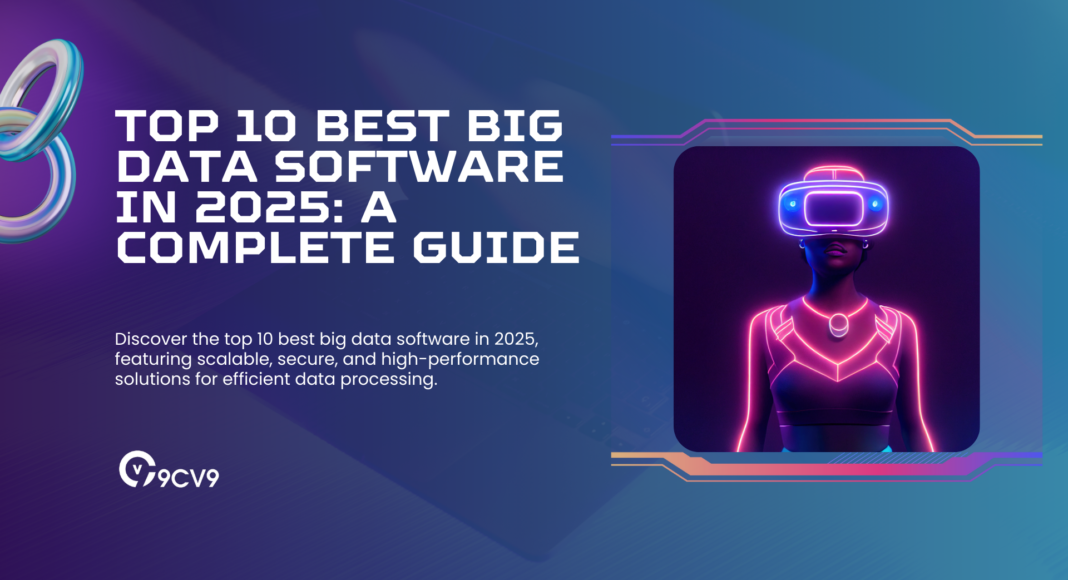Key Takeaways
- Discover the top big data software of 2025, designed for scalable, high-performance data processing and analytics.
- Learn how advanced tools like Databricks and Apache Kafka enhance real-time data processing and machine learning capabilities.
- Choose the best big data platform for your business needs, with powerful features for data integration, security, and real-time insights.
In an era where data is the new oil, the ability to harness, analyze, and derive meaningful insights from vast amounts of information is paramount for businesses and organizations.
The landscape of big data software in 2025 is more robust and sophisticated than ever, empowering companies to process complex datasets, enhance decision-making, and gain a competitive edge in their respective industries.
From real-time analytics to advanced machine learning integrations, these tools are revolutionizing how data is managed and utilized across the globe.
With the exponential growth of digital transformation, businesses are increasingly dealing with massive data volumes, often generated at breakneck speeds.
This trend has made the adoption of big data software not just an advantage but a necessity.
According to industry statistics, the global big data market is expected to surpass $400 billion by 2030, underscoring the growing demand for cutting-edge tools that can handle the intricacies of large-scale data management.
As a result, companies are on the lookout for reliable, scalable, and efficient big data solutions tailored to their unique needs.
This guide aims to provide a comprehensive overview of the top 10 big data software solutions in 2025.
Each tool featured here stands out for its advanced features, usability, and ability to address specific business challenges.
Whether you’re a tech enthusiast, a data scientist, or a business leader seeking to optimize your operations, this guide will help you understand what these software solutions bring to the table and how they can transform your data-driven strategies.
Why Choosing the Right Big Data Software Matters
Selecting the right big data software is crucial for ensuring that your organization can effectively process and analyze data.
Poorly chosen tools can lead to inefficiencies, inaccurate insights, and missed opportunities. With a diverse range of options available in 2025, understanding the key features and benefits of leading big data platforms is essential for making an informed decision.
This guide not only highlights the top tools but also delves into their unique capabilities, offering valuable insights into how they cater to various industries and use cases.
The solutions outlined in this guide are designed to cater to diverse organizational requirements.
You’ll discover how these tools leverage technologies like artificial intelligence, machine learning, and real-time processing to unlock the full potential of your data assets.
What to Expect in This Guide
- In-Depth Analysis: Explore detailed overviews of the top 10 big data software solutions, focusing on their standout features, pros, and cons.
- Industry Insights: Learn how these tools are shaping the future of data management and analytics across industries such as finance, healthcare, e-commerce, and manufacturing.
- Key Considerations: Understand the factors to consider when selecting the right big data software, including scalability, integration capabilities, cost-effectiveness, and ease of use.
By the end of this guide, you’ll have a clear understanding of the best big data software in 2025 and how each solution can empower your organization to thrive in a data-centric world. Whether you’re looking to streamline operations, enhance customer experiences, or innovate through predictive analytics, this guide is your ultimate resource for making data-driven decisions.
Before we venture further into this article, we would like to share who we are and what we do.
About 9cv9
9cv9 is a business tech startup based in Singapore and Asia, with a strong presence all over the world.
With over nine years of startup and business experience, and being highly involved in connecting with thousands of companies and startups, the 9cv9 team has listed some important learning points in this overview of the Top 10 Best Big Data Software in 2025.
If your company needs recruitment and headhunting services to hire top-quality employees, you can use 9cv9 headhunting and recruitment services to hire top talents and candidates. Find out more here, or send over an email to [email protected].
Or just post 1 free job posting here at 9cv9 Hiring Portal in under 10 minutes.
Top 10 Best Big Data Software in 2025: A Complete Guide
- APACHE Hadoop
- APACHE Spark
- The Tableau
- Cloudera
- APACHE Cassandra
- Apache Storm
- RapidMiner
- Talend
- Databricks
- Apache Kafka
1. APACHE Hadoop

Apache Hadoop has established itself as a cornerstone in the world of big data analytics, standing out as one of the most powerful and reliable platforms in 2025. Renowned for its scalability, flexibility, and robust processing capabilities, this Java-based, open-source software has become a go-to solution for businesses looking to efficiently store, process, and analyze massive datasets. Its ability to handle both structured and unstructured data seamlessly, coupled with its distributed computing framework, has solidified its position as an industry leader.
Tech giants such as Amazon, Microsoft, and IBM have adopted Apache Hadoop, further highlighting its effectiveness in managing data-intensive operations. Its cluster-based architecture enables parallel processing across multiple nodes, ensuring high-speed performance and fault tolerance, making it an indispensable tool for modern data-driven enterprises.
Why Apache Hadoop is Among the Best Big Data Software in 2025
Apache Hadoop’s inclusion in the top 10 big data software of 2025 is no coincidence. Its rich feature set, cross-platform support, and ability to scale across commodity hardware make it an exceptional choice for organizations of all sizes. Here’s an in-depth look at what sets Hadoop apart:
Key Features That Drive Apache Hadoop’s Excellence
- Efficient Data Storage with HDFS (Hadoop Distributed File System)
Hadoop’s HDFS is a highly scalable distributed file system that stores vast amounts of data across multiple nodes. Its fault-tolerant design ensures uninterrupted data availability, even in the event of hardware failures. - MapReduce Framework for Parallel Processing
The MapReduce algorithm enables distributed processing of large datasets across clusters in parallel, dramatically speeding up computation times and ensuring optimal use of resources. - Flexibility in Data Integration
Apache Hadoop seamlessly integrates with various data formats and systems, including MySQL, JSON, and NoSQL databases, offering unmatched versatility for diverse business needs. - Scalability on Commodity Hardware
Hadoop’s architecture is designed to scale effortlessly by adding nodes to the cluster. It works effectively on cost-efficient commodity hardware, reducing the need for expensive infrastructure. - Resource Management with YARN (Yet Another Resource Negotiator)
YARN acts as a dynamic resource manager, allocating resources and scheduling jobs efficiently to prevent overloading and ensure balanced cluster utilization. - Advanced Ecosystem Components
Hadoop’s ecosystem includes powerful tools that enhance its functionality:- Apache Hive: Offers an SQL-like interface for querying and managing large datasets.
- Apache HBase: A NoSQL database built on Hadoop, ideal for real-time processing.
- Apache Sqoop: Facilitates seamless data transfer between Hadoop and relational databases.
- Fault Tolerance and High Availability
Hadoop is designed to handle hardware failures gracefully by automatically reassigning tasks to other nodes, ensuring uninterrupted operations. - Support for All Data Types
Unlike many other platforms, Hadoop can process structured, semi-structured, and unstructured data, making it suitable for a wide range of applications, from text and images to videos and logs.
Advantages of Apache Hadoop
- Open-Source Framework: Being open-source, Hadoop is free to use, allowing businesses to leverage its capabilities without incurring high software costs.
- Cost-Effectiveness: By utilizing inexpensive hardware, Hadoop reduces the overall cost of big data management.
- High-Performance Processing: Its distributed architecture enables rapid processing of large-scale data workloads.
- Data Locality Optimization: Instead of moving data to the processing unit, Hadoop brings computation to the data, improving efficiency and reducing latency.
The Role of Apache Hadoop in 2025
In 2025, as data continues to grow at an unprecedented rate, Apache Hadoop remains indispensable for businesses aiming to stay competitive in a data-driven economy. Its ability to deliver reliable, scalable, and cost-efficient big data solutions empowers organizations across industries, from e-commerce and finance to healthcare and telecommunications.
By combining advanced features with a flexible architecture, Apache Hadoop not only meets but exceeds the demands of modern data analytics. Its ecosystem of tools and support for diverse data types ensures that businesses can unlock the full potential of their data, transforming it into actionable insights that drive growth and innovation.
2. APACHE Spark

Apache Spark has emerged as a transformative force in the big data landscape, securing its place among the top big data software in 2025. Renowned for its unmatched processing speed, scalability, and versatility, Apache Spark stands as a unified analytics engine capable of handling diverse workloads, including batch processing, real-time streaming, machine learning, and graph computation.
Its distributed computing capabilities empower organizations to process multi-petabyte datasets across clusters of machines, delivering unparalleled efficiency and reliability. What sets Apache Spark apart is its ability to perform in-memory data processing, significantly reducing latency and achieving speeds far superior to traditional disk-based systems. This performance edge is exemplified by Spark’s record-breaking ability to process 100 terabytes of data in just 23 minutes—a feat that outpaced Hadoop’s previous record by a wide margin.
Why Apache Spark is a Top Choice for Big Data in 2025
Apache Spark has solidified its position as a preferred solution for businesses navigating the complexities of big data. From its robust architecture to its seamless integration with machine learning (ML) and artificial intelligence (AI), Spark caters to the evolving demands of data-intensive industries. Here’s why Spark is considered a leader in big data analytics:
Key Features That Distinguish Apache Spark
- Blazing Speed with In-Memory Processing
Spark processes data in memory, eliminating the need for repetitive disk I/O operations. This enables real-time analytics and faster batch processing, giving businesses a critical advantage in making timely decisions. - Real-Time Data Streaming with Spark Streaming
Spark’s real-time processing capabilities allow it to handle continuous data streams with low latency. This makes it ideal for use cases such as fraud detection, network monitoring, and real-time recommendations. - Wide Language Compatibility
Spark supports multiple programming languages, including Java, Python, Scala, and R, making it accessible to a broad spectrum of developers and data scientists. - Scalability for Large Workloads
Spark is designed to handle massive datasets, scaling horizontally by adding nodes to its cluster. This scalability ensures that businesses can manage their growing data demands without compromising performance. - Advanced Machine Learning Capabilities with MLlib
Spark comes equipped with MLlib, a powerful machine learning library that supports algorithms for classification, regression, clustering, and collaborative filtering. These capabilities enable businesses to build sophisticated predictive models efficiently. - Structured Data Processing with Spark SQL
Spark SQL provides a dataframe-based approach to querying structured data, delivering a SQL2003-compliant interface. It seamlessly integrates with various data sources, including Apache Hive and JDBC. - Graph Processing with GraphX
Spark’s GraphX framework facilitates distributed graph computation, allowing users to perform ETL, exploratory analysis, and iterative operations on graph datasets. This feature is particularly beneficial for industries such as social networks, logistics, and bioinformatics. - Fault Tolerance for Reliable Operations
Spark’s robust architecture ensures data resilience through its fault-tolerant design, automatically recovering from failures without disrupting ongoing tasks. - Seamless Integration with Big Data Ecosystems
Apache Spark integrates effortlessly with other big data technologies, including Apache Hadoop and Kubernetes. This compatibility enables organizations to leverage their existing infrastructure while enhancing their analytics capabilities.
Advantages of Apache Spark
- Speed and Performance: Spark outshines competitors with its in-memory computing and real-time processing abilities.
- Versatility: From ML and AI to graph analytics, Spark supports a wide range of applications, making it a one-stop solution for diverse business needs.
- Ease of Use: Spark offers intuitive APIs, enabling developers and data analysts to work efficiently across multiple platforms.
- Cost-Effectiveness: Its compatibility with commodity hardware and open-source nature makes it a budget-friendly choice for organizations.
Industry Adoption of Apache Spark
Prominent companies, including Netflix, Uber, and Airbnb, have embraced Apache Spark for its ability to deliver real-time insights, scalability, and advanced analytics. These organizations leverage Spark to drive innovation, optimize operations, and deliver superior customer experiences.
Apache Spark: The Future of Big Data Analytics
In 2025, Apache Spark continues to revolutionize the way businesses harness the power of big data. Its comprehensive suite of features, coupled with its unmatched performance, positions it as an indispensable tool for industries looking to gain actionable insights from their data. Whether it’s powering AI-driven applications, enabling real-time decision-making, or scaling effortlessly with growing data volumes, Apache Spark is the ultimate solution for modern data challenges.
3. Tableau

Tableau has firmly established itself as a premier big data software solution, earning recognition as one of the top choices in 2025. Renowned for its unparalleled ability to transform raw data into compelling, interactive visualizations, Tableau empowers organizations to unlock deeper insights and make data-driven decisions with confidence. Its intuitive design, seamless integration capabilities, and user-friendly interface make it a standout tool in the competitive landscape of big data analytics.
Why Tableau is Among the Top Big Data Software in 2025
1. User-Centric Design for Simplified Data Exploration
Tableau’s drag-and-drop interface revolutionizes data visualization, allowing users to create sophisticated dashboards and reports without requiring extensive technical expertise. This accessibility has made Tableau a go-to solution for professionals across industries, from beginners to seasoned analysts.
2. Comprehensive Integration and Data Connectivity
Tableau excels at integrating diverse data sources, including databases, cloud storage, spreadsheets, and APIs. It enables users to blend data from multiple platforms, regardless of format or location, to create a unified view. This robust connectivity ensures that businesses can work seamlessly with heterogeneous data environments.
3. Interactive Visualizations for Enhanced Engagement
Tableau transforms static data into dynamic, interactive dashboards that foster deeper engagement. Users can drill down into datasets, filter views, and interact with visual elements to uncover insights that would otherwise remain hidden in traditional reports.
4. Real-Time Data Processing and Analytics
With real-time data processing capabilities, Tableau keeps users up to date with the latest trends and metrics. This feature is invaluable for applications such as sales tracking, operational monitoring, and performance analysis, where timely insights are critical.
5. Secure Collaboration for Team Success
Tableau’s collaborative features allow teams to share dashboards, reports, and insights effortlessly. Enhanced with robust data security measures, including row-level security, Tableau ensures that sensitive information is accessible only to authorized users. This combination of security and collaboration drives teamwork without compromising data integrity.
6. Advanced Analytics for Deeper Insights
Beyond visualization, Tableau integrates advanced analytics tools that help users extract actionable insights from complex datasets. From predictive modeling to statistical analysis, Tableau’s analytical depth equips businesses to stay ahead in a competitive landscape.
Standout Features of Tableau
- Drag-and-Drop Interface: Simplifies the creation of interactive visualizations and dashboards, making it accessible to all users.
- Data Blending: Combines disparate datasets into a single view, regardless of their origin or format.
- Real-Time Analytics: Processes and visualizes data in real time, ensuring decisions are based on the most current information.
- Row-Level Security: Limits data visibility based on user credentials, enhancing security and compliance.
- Collaboration Tools: Enables multiple users to work on projects simultaneously and share insights across teams.
- Custom Dashboards: Allows users to organize and present data in tailored dashboards that address specific business needs.
- Multi-Platform Integration: Seamlessly connects with data sources such as Salesforce, Microsoft Excel, Google Analytics, and more.
Why Tableau Stands Out in the Big Data Market
Tableau’s ability to turn massive, complex datasets into visually compelling narratives sets it apart from competitors. It provides organizations with the tools to explore data intuitively, extract meaningful insights, and communicate findings effectively. Its versatility, spanning industries like finance, healthcare, marketing, and manufacturing, makes it a valuable asset for businesses of all sizes.
Industry Adoption of Tableau
Global giants such as Amazon, LinkedIn, and Tesla rely on Tableau to harness the power of big data. From streamlining operations to enhancing customer experiences, Tableau’s impact is evident across sectors. Its robust ecosystem of features, combined with ongoing innovation, ensures it remains a top contender in the field of big data analytics.
Conclusion
In 2025, Tableau continues to lead the charge in data visualization and big data analytics. Its intuitive interface, powerful integration capabilities, and advanced analytical tools make it an indispensable asset for businesses aiming to thrive in a data-driven world. Whether for crafting interactive dashboards or enabling real-time collaboration, Tableau delivers a comprehensive solution that elevates big data visualization to new heights.
4. Cloudera

Cloudera continues to solidify its place as one of the top big data software solutions in 2025, offering a comprehensive suite of services and tools designed to help businesses efficiently manage, store, and analyze vast amounts of data. Its ability to deliver scalable solutions across various domains, including data engineering, data warehousing, machine learning, and more, has made it a go-to platform for enterprises seeking to derive meaningful insights from big data.
Why Cloudera Ranks Among the Best Big Data Software in 2025
1. Unmatched Scalability for Expanding Data Needs
One of Cloudera’s key strengths lies in its scalability. As businesses generate increasing amounts of data, Cloudera’s platform can easily handle growing volumes, ensuring that organizations can seamlessly scale their data storage and processing infrastructure. Whether on-premise, in the cloud, or in hybrid environments, Cloudera provides the flexibility to expand as required, accommodating the dynamic nature of modern data environments.
2. Comprehensive Integration Across Technologies
Built on the robust Apache Hadoop framework, Cloudera integrates various powerful components such as Hadoop Distributed File System (HDFS), Apache Spark, Apache Hive, and Apache Kafka. This unified platform enables users to process, store, and analyze large datasets effortlessly, making it a highly versatile solution for organizations with diverse data analytics needs. Additionally, Cloudera supports seamless integration with other big data technologies, amplifying its utility in complex environments.
3. Enhanced Security and Governance
Cloudera has positioned itself as a leader in security within the big data space. With Cloudera’s Ranger providing centralized management of security policies, businesses can ensure that sensitive data remains secure throughout its lifecycle. The platform also includes strong governance features, which are essential for industries that require compliance with stringent regulatory standards. These security and governance features are a significant reason why enterprises trust Cloudera with their data management needs.
4. Advanced Analytics and Machine Learning Capabilities
Cloudera is more than just a data storage and processing platform. It provides cutting-edge machine learning and artificial intelligence tools that empower businesses to extract valuable insights from their data. With Cloudera Data Science Workbench, users can manage analytics pipelines, develop machine learning models, and deploy them in production environments. This makes Cloudera a powerful tool for businesses that rely on data-driven decisions powered by AI and ML.
5. Optimized Performance and Flexibility
Designed with the needs of modern businesses in mind, Cloudera offers exceptional performance and flexibility. Organizations can choose to deploy the platform in private clouds, public clouds, or hybrid environments, giving them the freedom to optimize their infrastructure based on their specific requirements. This versatility ensures that Cloudera can be tailored to meet the needs of any enterprise, regardless of size or industry.
Standout Features of Cloudera
- Scalable Data Storage: Cloudera’s hybrid architecture allows businesses to scale storage and processing capabilities in line with their growing data needs.
- Apache Hadoop Integration: At its core, Cloudera leverages Hadoop, enabling distributed storage and processing of massive data sets across multiple nodes.
- Data Science and Machine Learning: The platform includes advanced tools for developing and deploying machine learning models, ensuring businesses can extract actionable insights from complex data.
- Security and Governance: Cloudera provides robust data security features, including centralized management and enterprise-grade governance, making it ideal for businesses in regulated industries.
- Comprehensive Analytics Tools: Cloudera’s suite of tools, including Cloudera Data Science Workbench and CDP for data exploration, visualization, and advanced analytics, empowers users to unlock deep insights from their data.
- Automated Cluster Management: Cloudera Manager automates many tasks, including deploying software, configuring clusters, and scaling them to handle increasing data loads.
- Data Integration and Indexing: The platform seamlessly integrates data from various sources, while Cloudera Search enables real-time indexing, providing fast access to large datasets.
Enterprise Adoption of Cloudera
Prominent companies across industries trust Cloudera to handle their big data analytics needs. Leading organizations such as Dell, Nissan, and Comcast rely on Cloudera’s hybrid data platform to process and analyze their vast data sets, driving innovation and achieving significant business outcomes.
Conclusion
Cloudera remains one of the top big data platforms in 2025 due to its scalability, comprehensive integration, robust security, and advanced analytics capabilities. Its ability to handle large volumes of data, facilitate machine learning, and offer flexible deployment options makes it an indispensable tool for enterprises seeking to harness the power of big data. With Cloudera, organizations are well-equipped to navigate the complexities of big data management, drive insights, and foster innovation in an increasingly data-driven world.
5. APACHE Cassandra

In 2025, Apache Cassandra remains a cornerstone in the world of big data solutions, renowned for its high scalability, fault tolerance, and impressive speed. As an open-source NoSQL distributed database, it is designed to handle vast amounts of data with minimal downtime, making it an ideal choice for enterprises that require continuous data operations and large-scale processing. Originally created by Facebook in 2008 and later released to the public, Cassandra has garnered widespread praise for its ability to process petabytes of data at lightning-fast speeds, all while ensuring high availability and seamless data distribution.
Why Apache Cassandra is Among the Best Big Data Software in 2025
1. Unmatched Scalability and Performance
One of the key features that set Apache Cassandra apart from other big data software is its linear scalability. The platform is built with a peer-to-peer architecture that allows businesses to effortlessly expand their database by simply adding more nodes to the cluster. This scalability ensures that as data requirements grow, the performance of the system remains constant, making Cassandra an invaluable tool for handling massive datasets. Whether dealing with terabytes or petabytes, Cassandra can scale without compromising performance or speed, which is essential for businesses experiencing rapid data growth.
2. Decentralized Architecture for Maximum Availability
Cassandra’s decentralized design eliminates the risk of a single point of failure, ensuring that there is no bottleneck or interruption in service. Data is replicated across multiple nodes and data centers, which not only improves the platform’s availability but also provides redundancy in case of hardware failure. This feature makes it highly suitable for applications where uptime is critical, ensuring that data remains accessible even during unexpected outages or maintenance.
3. Seamless Data Distribution and Global Deployments
Apache Cassandra excels in distributing data across multiple geographic locations. By replicating data on various data centers, Cassandra guarantees data availability, even if one data center goes offline. This global distribution capability makes it a go-to solution for enterprises with global operations, enabling businesses to maintain high-performance data access and consistency no matter where they are located.
4. Fast Processing with Minimal Latency
One of the standout features of Apache Cassandra is its ability to deliver exceptionally fast processing speeds, handling thousands of operations per second without any noticeable delay. By running on commodity hardware, Cassandra ensures that businesses do not need to invest in expensive infrastructure while still reaping the benefits of fast data processing. This speed is particularly important for big data applications that need to process real-time data streams, such as those in finance, telecommunications, and social media analytics.
5. Fault Tolerance for Reliable Operations
Fault tolerance is another area where Apache Cassandra excels. The platform automatically handles node failures without impacting the overall performance or availability of data. If any node goes down, it is swiftly replaced, and the system continues to function normally without interruption. This ensures that businesses can rely on Cassandra for continuous service, even in the face of unexpected hardware issues.
Key Features of Apache Cassandra
- Scalability: Thanks to its peer-to-peer architecture, Cassandra can scale horizontally by adding nodes to the cluster, which increases capacity without affecting performance.
- Fault Tolerance: With automatic data replication across nodes, Cassandra ensures that data is always available, even if individual nodes fail.
- High Performance: Cassandra’s design allows for fast write operations while maintaining high read efficiency, making it suitable for high-volume data processing applications.
- Data Distribution: The platform can distribute data across multiple data centers, ensuring global availability and redundancy in the event of a failure.
- Flexible Data Structures: Cassandra supports a variety of data structures, providing flexibility in how data is stored and processed.
- Tunable Consistency: Cassandra offers tunable consistency levels, allowing users to adjust the trade-off between consistency and availability based on their specific use case.
- Cassandra Query Language (CQL): Similar to SQL, CQL enables users to define and manipulate data in a simple, familiar syntax, making it easier for developers to work with.
- Integration Capabilities: Cassandra can be easily integrated with other open-source tools and platforms, such as Xplenty for ETL processes, allowing businesses to leverage additional data processing capabilities.
Conclusion
As one of the top big data software solutions in 2025, Apache Cassandra stands out for its scalability, fault tolerance, and performance under heavy workloads. Its ability to handle vast amounts of data with minimal downtime makes it an essential tool for businesses that need reliable, high-speed data processing and global data distribution. With features like flexible data storage, tunable consistency, and integration capabilities, Cassandra is equipped to meet the complex demands of modern enterprises. For organizations looking to manage and analyze massive datasets at scale, Apache Cassandra remains a top-tier choice in the realm of big data software.
6. Apache Storm

As one of the top contenders in big data software in 2025, Apache Storm stands out for its exceptional capabilities in real-time data processing and horizontal scalability. This open-source, distributed real-time computation system has proven to be a game-changer for organizations requiring efficient handling of large volumes of data in real time. Initially developed to overcome the challenges of processing massive data streams with low latency, Apache Storm has since become a go-to solution for tech giants like Twitter, Zendesk, and NaviSite. Its robust architecture, combined with its ability to handle complex tasks with ease, positions Apache Storm among the top 10 best big data software in 2025.
Why Apache Storm is Among the Top Big Data Software in 2025
1. Unmatched Real-Time Data Processing
One of the defining features of Apache Storm is its ability to process data in real-time. This capability is crucial for applications that require immediate insights from data, such as live analytics, monitoring systems, or event-driven applications. Storm’s real-time processing architecture enables businesses to act on data instantly, which is especially important in industries such as finance, telecommunications, and social media analytics. By processing data streams as they arrive, Storm provides timely and actionable insights that help organizations make data-driven decisions quickly.
2. Distributed and Scalable Architecture
Apache Storm’s distributed system is a standout feature that enhances its scalability and performance. This architecture allows workloads to be distributed across multiple nodes, which ensures that the system remains highly scalable even as the amount of data increases. Organizations can easily add nodes to their clusters to accommodate growing data processing needs, making Apache Storm ideal for businesses experiencing rapid growth or handling large, dynamic datasets. With its horizontal scalability, Storm delivers uninterrupted service and performance, even when the data load spikes.
3. Fault Tolerance and Reliability
Another reason Apache Storm ranks among the top big data solutions is its fault-tolerant design. Storm ensures that data processing continues uninterrupted, even if a node or component fails. This capability is vital for businesses that rely on consistent data flow and cannot afford downtime. The system automatically recovers from failures, rerouting data processing to healthy nodes, which maintains the stability and reliability of operations. For enterprises working with mission-critical applications, this fault tolerance provides an essential layer of security and ensures that no data is lost, even during failures.
4. High-Speed Data Processing
Apache Storm’s processing speed is one of its most remarkable attributes. The system can process up to 1 million messages of 100 bytes each on a single node, which makes it capable of handling massive volumes of incoming data with minimal latency. This high throughput allows businesses to work with large-scale data streams without sacrificing performance, ensuring that even the most data-intensive applications can run smoothly.
5. Flexible Language Support
Apache Storm is highly versatile, supporting a wide range of programming languages, which makes it easy to integrate into existing systems. Whether a business uses Java, Python, or other programming languages, Apache Storm can adapt to meet the requirements of different projects. This flexibility is especially beneficial for teams that work with multiple programming languages, enabling them to build and deploy solutions efficiently without facing language limitations.
6. Low Latency for Time-Sensitive Applications
For applications that require immediate responses—such as fraud detection, stock market analysis, and IoT monitoring—low latency is crucial. Apache Storm excels in this area, offering a remarkably low-latency environment for processing data in real-time. The system can quickly process incoming data streams and generate results almost instantaneously, making it an ideal choice for businesses with time-sensitive operations.
7. High Throughput for Massive Data Volumes
With its ability to handle high throughput, Apache Storm is designed to process millions of tuples per second, making it perfect for large-scale data ingestion and analysis. Whether dealing with live data feeds, social media streams, or sensor data, Storm can manage the high-volume, high-velocity demands of modern data workflows. This capability ensures that businesses can process enormous amounts of data without delays or bottlenecks, which is essential in industries where speed and volume are paramount.
8. Stream Processing Model for Flexibility and Control
Apache Storm utilizes a stream processing model, which allows businesses to define data flows using components known as “spouts” (which ingest data) and “bolts” (which process data). This model offers flexibility and control over how data is handled and transformed in the system. Organizations can easily build and customize their data processing workflows by creating topologies that suit their specific needs, enabling them to optimize data processing and ensure efficiency at every stage.
Conclusion
As one of the leading big data tools in 2025, Apache Storm provides an unparalleled combination of real-time data processing, scalability, fault tolerance, and performance. Its distributed architecture ensures that businesses can manage increasing data volumes while maintaining high performance, while its low-latency capabilities enable immediate insights from data streams. With its support for multiple programming languages, high throughput, and flexible stream processing model, Apache Storm is an essential tool for businesses looking to harness the power of big data for real-time decision-making. For organizations that require speed, reliability, and scalability in their data processing systems, Apache Storm remains one of the top choices in the big data landscape.
7. RapidMiner

As one of the most advanced and versatile analytics platforms available in 2025, RapidMiner continues to establish itself as a top choice for data scientists, analysts, and organizations across a wide range of industries. Offering a comprehensive suite of tools for data preparation, machine learning, deep learning, text mining, and predictive analytics, RapidMiner empowers users to extract actionable insights from their data without requiring extensive coding knowledge. Whether operating in a code-free or code-friendly environment, RapidMiner meets the diverse needs of both beginners and seasoned professionals in the field of data science. Its blend of user-friendliness, robust functionality, and deep integration options makes it one of the best big data software solutions available today.
Why RapidMiner is One of the Top Big Data Software in 2025
1. Intuitive and Visual Workflow Design
RapidMiner stands out with its drag-and-drop interface, which enables users to build and visualize complex analytics models and data workflows without writing extensive code. This visual workflow designer is perfect for those who may not have deep programming experience but still need to perform sophisticated data analysis. The ability to easily manipulate data, create models, and visualize results without having to write a single line of code opens up data science to a broader audience, empowering businesses to harness the full potential of their data with minimal technical barriers.
2. Comprehensive Machine Learning Capabilities
RapidMiner offers an extensive array of machine learning models, covering a variety of needs, including classification, regression, clustering, and even deep learning. Whether organizations are working with supervised learning algorithms (such as decision trees, support vector machines, and linear regression) or unsupervised learning techniques (such as K-Means clustering and DBSCAN), RapidMiner provides the necessary tools to build and deploy predictive models efficiently. Its advanced analytics tools empower businesses to make data-driven predictions and uncover hidden patterns within their datasets, which are crucial for industries such as healthcare, finance, automotive, and retail.
3. Seamless Data Preparation and Transformation
Data preparation is one of the most time-consuming aspects of data analytics. RapidMiner simplifies this process with its suite of data cleaning, transformation, and reduction tools. The platform allows users to automatically preprocess data, clean up inconsistencies, and format datasets for analysis, significantly streamlining the workflow. This is essential for organizations dealing with large, messy datasets, ensuring that the data is in the right format for advanced analytics and machine learning. By automating many of these tasks, RapidMiner reduces manual effort and accelerates the time-to-insight.
4. Powerful Integration and Scalability
One of the most compelling reasons why RapidMiner is a leading big data software in 2025 is its scalable integration capabilities. The platform can easily connect with a wide variety of data sources, including databases, SaaS platforms, and cloud applications. Whether pulling data from enterprise resource planning (ERP) systems or integrating with third-party applications, RapidMiner enables smooth data workflows and integration with existing systems. As organizations grow and their data needs evolve, RapidMiner scales effortlessly, allowing users to expand their projects and work with increasingly complex datasets without compromising performance.
5. Automated Workflow for Increased Efficiency
RapidMiner’s ability to automate data workflows significantly enhances operational efficiency. By automating repetitive tasks such as data preprocessing, feature selection, and model evaluation, the platform frees users from performing manual tasks and enables them to focus on more strategic aspects of data analysis. This functionality not only saves time but also ensures that workflows are executed consistently, reducing human error and increasing productivity across teams.
6. Advanced Analytics and Visualization Options
With its robust visualization options, RapidMiner allows users to gain deeper insights into their data. The platform provides a variety of charting, plotting, and graphical tools that help users identify trends, patterns, and outliers in their data. These visualizations are invaluable for making data-driven decisions, providing clear and actionable insights in an easily digestible format. The ability to visualize complex data relationships and model outputs in real-time fosters a more comprehensive understanding of data, which is crucial for making informed decisions.
7. Flexibility for Code-Free and Code-Friendly Users
RapidMiner’s flexibility sets it apart from many other data analytics platforms. While it offers a code-free environment ideal for beginners and business analysts, it also allows advanced users to integrate Python or R scripts for customizations and advanced functionality. This versatility enables both non-technical users and data scientists to leverage the platform effectively, making RapidMiner a powerful tool for teams with diverse technical expertise.
8. Collaboration and Teamwork Features
Data analytics is often a collaborative effort, and RapidMiner supports this with its collaboration tools. These features enable teams to work together seamlessly, sharing insights, models, and workflows. Whether working on a project with cross-functional teams or collaborating with external partners, RapidMiner fosters efficient teamwork, ensuring that all stakeholders can contribute to the decision-making process. This collaborative approach is particularly valuable for organizations with large data science teams that need to work on the same data models and analysis tasks.
Conclusion
RapidMiner stands as one of the top big data software solutions in 2025 due to its powerful combination of intuitive design, advanced machine learning tools, and seamless integration capabilities. It is a platform that meets the diverse needs of modern organizations by providing both code-free and code-friendly environments for data preparation, machine learning, and predictive analytics. Whether users are cleaning and transforming data, building predictive models, or visualizing trends, RapidMiner offers the flexibility, scalability, and user-friendliness required for today’s fast-paced data-driven decision-making. Its ability to automate workflows, integrate with existing systems, and foster collaboration makes it an indispensable tool for any organization seeking to maximize the value of its data and gain a competitive edge in the marketplace.
8. Talend

In 2025, Talend has firmly established itself as one of the top big data software solutions, offering unparalleled capabilities in data integration, transformation, and management. As an open-source platform, Talend empowers organizations to streamline their data workflows, integrate disparate systems, and ensure high-quality, reliable data for decision-making. Its broad compatibility with a variety of data sources and its intuitive graphical interface make it an essential tool for businesses operating in the increasingly complex data landscape of today.
Talend’s data extraction, transformation, and loading (ETL) capabilities simplify the complexities of working with big data, allowing enterprises to extract, transform, and load data seamlessly from a diverse range of sources, whether on-premises or in the cloud. By automating and optimizing data workflows, Talend enhances data integration and governance while ensuring consistency and accuracy across all stages of data processing.
Why Talend is One of the Best Big Data Software in 2025
1. Intuitive Graphical Interface for Seamless Data Integration
One of the key features that set Talend apart from other big data software is its user-friendly graphical interface. This interface simplifies the complex task of designing and managing data transformation and integration processes, allowing both technical and non-technical users to contribute effectively. By providing a drag-and-drop functionality, Talend eliminates the need for intricate coding, making it accessible to a broader audience and reducing the learning curve for new users. This intuitive design empowers teams to visually represent their data pipelines and streamline their workflows, enhancing overall productivity and efficiency.
2. Comprehensive Support for Various Data Sources
Talend’s wide range of connectors supports an extensive variety of data sources, including traditional databases, cloud applications, and big data environments. This ensures that organizations can seamlessly integrate data from multiple systems, whether it’s structured, semi-structured, or unstructured data. Talend’s versatility in handling diverse data environments makes it an invaluable tool for companies working with complex data ecosystems, as it can connect and integrate data across on-premises systems, cloud platforms, and hybrid environments.
3. Advanced Data Transformation and Management
At the heart of Talend’s capabilities is its robust suite of data transformation tools, which allow businesses to modify and structure data in ways that provide valuable insights. Whether handling real-time or batch data processing, Talend ensures that data is not only integrated but transformed into a form that is meaningful and actionable. The platform supports a variety of transformation operations such as data cleansing, deduplication, and validation, which are critical for maintaining data quality throughout the process. By providing these advanced capabilities, Talend helps organizations turn raw data into high-quality, usable insights that drive better business decisions.
4. Uncompromised Data Quality Assurance
Maintaining data integrity is a critical concern for businesses, especially when data forms the foundation of strategic decision-making. Talend addresses this concern head-on by incorporating data quality tools that assess and ensure data accuracy across six essential dimensions: completeness, timeliness, validity, accuracy, consistency, and uniqueness. With these built-in tools, organizations can continuously monitor and measure data quality, ensuring that any issues are detected and rectified before they impact business operations. Furthermore, Talend provides customizable dashboardsthat visualize data quality metrics, allowing teams to quickly identify and address any discrepancies or inconsistencies in their datasets.
5. Seamless Cloud Integration and Real-Time Data Management
In the age of cloud computing, the ability to integrate both on-premises and cloud-based data is essential. Talend excels in this area by offering cloud integration capabilities that allow businesses to manage, cleanse, and transform data from both environments in real time. With pre-built templates and graphical tools, Talend simplifies cloud data integration, making it easier to extract valuable insights from data stored in cloud platforms such as AWS, Microsoft Azure, and Google Cloud. This cloud integration functionality is especially beneficial for organizations that rely on hybrid data architectures, ensuring that all data—whether stored locally or remotely—is seamlessly connected and processed.
6. Efficient ETL and ELT Processes
Talend streamlines both ETL (Extract, Transform, Load) and ELT (Extract, Load, Transform) workflows, making data integration and management more efficient. By automating these processes, Talend reduces the manual effort required to prepare data for analysis, improving both the speed and accuracy of data processing. Whether working with massive volumes of data or small-scale datasets, Talend ensures that businesses can handle and transform data with minimal disruption to their operations. Its extensive library of pre-built connectors for custom solutions further enhances its flexibility, enabling it to adapt to various organizational needs and technical requirements.
7. Scalability and Customizability for Diverse Data Needs
As data volumes continue to grow, scalability is a key consideration for businesses investing in big data software. Talend’s scalable architecture allows organizations to expand their data operations without experiencing performance degradation. Whether processing small datasets or handling big data workloads, Talend’s infrastructure is designed to scale according to the organization’s needs. Moreover, Talend’s customizability, through its support for programming languages like Java, Python, and SQL, ensures that users can tailor the platform to their specific business requirements and integrate it into their existing systems and workflows with ease.
8. Enhanced Collaboration Features
As data analysis becomes increasingly collaborative, Talend supports team collaboration by enabling users to share insights, models, and workflows within a centralized platform. This enhances communication and cooperation between data teams, business analysts, and IT departments, fostering a more collaborative and efficient decision-making process. Talend’s collaborative features make it easier for cross-functional teams to work together and ensure that insights derived from big data are accessible and actionable for all stakeholders involved.
Conclusion
In 2025, Talend continues to be a top choice for organizations seeking a powerful, open-source solution for big data integration and management. Its comprehensive capabilities in data transformation, cloud integration, and data quality assurance make it an indispensable tool for businesses working with diverse and complex datasets. By providing an intuitive interface, a wide range of connectors, and advanced features for data cleansing, validation, and governance, Talend ensures that organizations can manage their data with confidence and precision. Whether handling real-time or batch processing, Talend provides the tools necessary to maintain data quality, integrate multiple data sources, and ultimately drive better business outcomes. Its adaptability, scalability, and collaborative features make it one of the most reliable and effective big data software solutions available in 2025.
9. Databricks

In 2025, Databricks continues to stand as one of the leading platforms in the field of big data analytics and machine learning. Built on the robust and powerful Apache Spark, Databricks unifies data engineering, analytics, and machine learning into a single platform, making it a go-to choice for enterprises seeking to innovate, scale, and streamline their data processes. With its advanced features designed to accelerate workflows, enhance collaboration, and support both batch and real-time data processing, Databricks has solidified its place among the Top 10 Best Big Data Software in 2025.
Databricks is recognized for its ability to provide a unified environment where data engineers, data scientists, and analysts can collaborate seamlessly on large-scale data processing and machine learning projects. By integrating essential functions—such as data processing, advanced analytics, and machine learning—into a single, cohesive platform, Databricks eliminates silos and reduces the complexity of managing diverse data workflows. Its ability to scale to handle vast datasets and perform real-time analytics positions it as an invaluable tool for modern data-driven enterprises.
Why Databricks is Among the Best Big Data Software in 2025
1. Comprehensive Data Processing and Analytics Integration
One of the most significant advantages of Databricks is its seamless integration of data processing, analytics, and machine learning. This unified approach simplifies the entire data pipeline—from ingestion to real-time analytics, and even predictive modeling—into a single platform. The platform leverages Apache Spark, a fast and scalable distributed computing system, to efficiently process large volumes of structured and unstructured data, making it ideal for enterprises that need to process massive datasets in real time. Whether it’s batch processing or streamlining data with Apache Spark Streaming and Structured Streaming, Databricks ensures that organizations can leverage all their data for timely insights and decision-making.
2. Scalability to Handle Big Data Workloads
Databricks excels in its scalability, a crucial feature for businesses that require the ability to handle large datasets and complex workloads. As data grows in volume and complexity, the platform can scale effortlessly to meet the demands of real-time processing, ensuring that enterprises can continue to innovate and grow without worrying about system limitations. Its underlying architecture, powered by Apache Spark, allows Databricks to scale efficiently across a wide range of data environments, from on-premises infrastructure to cloud-based platforms. This scalability ensures that Databricks remains a future-proof solution, adaptable to the growing demands of big data workloads in 2025 and beyond.
3. Collaborative Features for Seamless Teamwork
A standout feature of Databricks is its collaborative environment that enhances teamwork among data engineers, data scientists, and business analysts. By providing interactive notebooks and dashboards, Databricks enables teams to collaborate on data projects in real time, with the ability to share insights, code, and visualizations instantly. This collaborative capability is crucial for accelerating the time-to-insight, as it ensures that different teams can work together more efficiently, reducing silos and increasing productivity. The platform’s shared workspace fosters a culture of collaboration, which is essential in today’s fast-paced, data-driven business landscape.
4. Built-in Machine Learning Libraries and AI Capabilities
Databricks offers a rich suite of machine learning (ML) capabilities that make it a leader in AI-driven applications. With built-in libraries for ML modeling, tracking, and serving, Databricks simplifies the process of developing, training, and deploying machine learning models. Additionally, it supports feature engineering and model management, which are critical for optimizing the accuracy and efficiency of machine learning models. Databricks also offers cutting-edge Generative AI solutions, enabling organizations to leverage AI for a wide variety of use cases, from natural language processing (NLP) to advanced predictive analytics. Its robust ML framework empowers businesses to harness the full potential of AI, driving innovation and improving business outcomes.
5. Real-Time Analytics and Intelligent Insights
Real-time analytics is another standout feature of Databricks that significantly enhances its value proposition. By combining the power of Apache Spark Streaming with intelligent analytics tools, Databricks enables organizations to analyze data as it arrives, unlocking immediate insights that can influence decision-making in real time. This is particularly valuable for businesses that operate in dynamic environments, where timely responses to changing conditions are crucial. Whether it’s monitoring live sensor data, tracking website interactions, or analyzing customer sentiment, Databricks ensures that organizations can stay ahead of the curve by providing insights as they happen.
6. Comprehensive Security, Governance, and Disaster Recovery
For any enterprise handling sensitive or critical data, security and governance are top priorities. Databricks provides a comprehensive suite of tools for managing data security, compliance, and disaster recovery, ensuring that data is protected throughout its lifecycle. With features like schema enforcement, data lineage tracking, and role-based access control, Databricks helps organizations maintain strict governance and compliance standards while ensuring that sensitive information remains secure. The platform’s robust disaster recovery mechanisms further enhance its reliability, providing peace of mind that data is always available, even in the event of unexpected disruptions.
7. Optimized Data Discovery and Exploration Tools
Databricks offers powerful data discovery and exploration tools that allow users to quickly identify, annotate, and explore datasets. These tools are designed to accelerate the process of data preparation and exploration, enabling users to gain insights faster and with greater accuracy. Whether analyzing historical trends or identifying patterns in real-time data, Databricks’ data discovery features provide a comprehensive overview of available datasets, ensuring that businesses can make more informed decisions and drive better outcomes.
Conclusion
As one of the most robust and versatile platforms in the field of big data analytics, Databricks continues to be a top contender among the best big data software in 2025. With its integration of data processing, machine learning, and real-time analytics, Databricks simplifies the complexities of working with large-scale datasets, enabling organizations to gain insights and make data-driven decisions with speed and accuracy. Its scalability, collaborative features, and advanced security and governance tools make it an ideal solution for enterprises that require a high level of flexibility and reliability in their data workflows. With built-in machine learning capabilities, real-time data processing, and comprehensive support for modern analytics, Databricks is set to remain a leader in the big data space for years to come.
10. Apache Kafka

As one of the Top 10 Best Big Data Software in 2025, Apache Kafka remains a powerful and highly scalable solution for real-time data processing. Originally developed by LinkedIn and later open-sourced to Apache in 2011, Kafka has evolved into a premier distributed event streaming platform trusted by major global enterprises, including over 80% of the Fortune 100 companies. It is particularly well-regarded for its ability to manage large-scale, high-throughput data feeds, making it a top choice for building data pipelines and streaming applications. Kafka’s sophisticated architecture allows businesses to seamlessly process, store, and analyze real-time data streams with minimal latency, making it indispensable for modern data-driven applications.
Apache Kafka’s core functionality revolves around its ability to decouple systems and data streams, enabling seamless integration between different services and applications. It provides an efficient framework for publishing, subscribing, and processing data streams, allowing organizations to handle millions of messages per second. This capability makes Kafka the go-to solution for a wide variety of use cases, including log aggregation, stream processing, and real-time analytics.
Why Apache Kafka is Among the Best Big Data Software in 2025
1. Exceptional Scalability and Performance
One of the defining characteristics of Apache Kafka is its remarkable scalability. Kafka’s architecture is designed to grow horizontally, which means that its clusters can scale seamlessly by simply adding more nodes, enabling it to handle increasing data loads without compromising performance. This elasticity makes Kafka an ideal solution for businesses that anticipate rapid data growth and require a platform that can expand without disruptions. Whether for small-scale applications or enterprise-level systems, Kafka’s ability to handle massive amounts of data in real time positions it as a highly effective tool for large-scale big data operations.
2. High-Throughput Data Processing
Apache Kafka is engineered to process massive volumes of data concurrently, making it capable of handling millions of messages per second. The platform’s high throughput ensures that businesses can process and analyze data streams at scale without facing bottlenecks or latency issues. This is particularly crucial in environments where data must be processed in near real-time, such as in stream processing or for real-time analytics. Kafka’s ability to efficiently handle high-throughput workloads positions it as a preferred choice for organizations with demanding data processing requirements.
3. Real-Time and Batch Processing Flexibility
Kafka’s versatile nature allows it to support both real-time processing and batch processing of data. This flexibility makes Kafka a powerful tool for applications that require the ability to handle data in a variety of formats and processing methods. Whether it’s streaming data to analytics systems, integrating data with other big data sources, or processing data in batches, Kafka delivers high performance across multiple processing paradigms. It is particularly effective in use cases where data needs to be ingested, processed, and delivered to multiple systems without any performance degradation.
4. Fault Tolerance and Data Reliability
One of Kafka’s most crucial features is its fault tolerance, which ensures that data is not lost in the event of system failures. Kafka uses replication to back up data across multiple brokers, which ensures that even if one server fails, the data is preserved and can be accessed from another server. This high level of reliability makes Kafka an indispensable tool for organizations that cannot afford to lose any data, especially in mission-critical applications that rely on real-time data.
5. Integration with a Variety of Data Sources
Apache Kafka’s ability to integrate seamlessly with multiple big data sources is one of the factors that sets it apart. Kafka can process data from diverse systems such as Hadoop, Cassandra, S3, Storm, and Flink, making it highly adaptable to various enterprise data architectures. Its capacity to handle data from different platforms and unify them into a single processing stream enables businesses to streamline their data workflows and achieve greater operational efficiency.
6. Robust Security Features
Security is paramount when working with sensitive data, and Apache Kafka provides multiple layers of protection to ensure that data remains secure. Kafka supports SASL (Simple Authentication and Security Layer) user identity authentication and SSL (Secure Sockets Layer) encryption, which guarantees that data is transmitted and stored securely. These security features ensure that organizations can protect their data from unauthorized access and comply with industry regulations.
7. Cost-Effectiveness
Despite its enterprise-grade capabilities, Apache Kafka is remarkably cost-effective when it comes to managing large volumes of data. Kafka is optimized for high-performance data processing without requiring significant investment in infrastructure. Its ability to handle high-throughput workloads while minimizing operational overhead makes it an affordable option for businesses of all sizes, from startups to multinational corporations. This balance of performance and cost-efficiency contributes to its popularity among organizations seeking scalable, budget-conscious big data solutions.
8. Fault Tolerance and Data Integrity
Kafka’s replication and fault tolerance capabilities ensure high data availability, even when individual servers or brokers fail. The platform guarantees data integrity by replicating data across multiple nodes, ensuring that no data is lost during failure events. This feature is particularly vital for enterprises that cannot afford data loss, such as those involved in financial services, healthcare, and telecommunications.
Key Features of Apache Kafka
- Event Streaming: Kafka supports real-time event streaming, enabling businesses to react to events as they occur and enabling dynamic data pipelines.
- Fault Tolerant Architecture: Built with fault tolerance in mind, Kafka provides high availability even in the event of system failures.
- Scalability: Kafka clusters can be horizontally scaled to accommodate growing data processing demands, allowing organizations to add brokers to handle increasing data loads.
- High Throughput: Kafka excels at handling millions of concurrent messages per second, making it ideal for real-time data processing scenarios.
- Batch and Stream Processing: Kafka supports both batch processing and real-time streaming of data, offering flexibility for various business use cases.
- Seamless Integration: Kafka integrates with a wide range of data sources, including Hadoop, Cassandra, and cloud storage systems, to facilitate data workflows across diverse platforms.
- Security: With SSL encryption and SASL authentication, Kafka ensures that data remains protected from unauthorized access, providing a secure environment for data transmission and storage.
Conclusion
As a distributed event streaming platform, Apache Kafka continues to be a cornerstone of modern big data infrastructure, earning its place among the Top 10 Best Big Data Software in 2025. Kafka’s ability to scale horizontally, process millions of messages per second, and integrate seamlessly with a wide range of data sources makes it a go-to solution for organizations in need of high-performance, real-time data processing. With robust features for fault tolerance, real-time analytics, and streaming data management, Kafka is indispensable for businesses that rely on fast, reliable, and cost-effective big data solutions. Its widespread adoption and proven capabilities across industries ensure that Kafka remains at the forefront of big data technologies well into the future.
Conclusion
As we look ahead to 2025, the demand for efficient, scalable, and high-performance big data software has never been greater. The ever-expanding landscape of digital data, combined with the rise of technologies such as artificial intelligence (AI), machine learning (ML), and cloud computing, has made it imperative for organizations to adopt robust and reliable data processing solutions. The software listed in this guide represents the top 10 best big data platforms that are set to revolutionize the way businesses collect, store, process, and analyze vast volumes of data.
These platforms cater to a wide array of use cases, from real-time analytics to advanced machine learning, enabling businesses across various industries—from finance and healthcare to telecommunications and retail—to make data-driven decisions with ease and efficiency. With the top big data software solutions for 2025 offering enhanced scalability, flexibility, security, and integration capabilities, organizations can address their most complex data challenges while unlocking new opportunities for growth and innovation.
Key Takeaways from the Top Big Data Software of 2025
- Unmatched Scalability: Leading big data software platforms like Apache Kafka, Databricks, and Snowflakeprovide unparalleled scalability. This ensures that businesses can scale their data processing capabilities as their operations grow, without experiencing performance bottlenecks or latency issues. As data volumes continue to skyrocket, the ability to scale horizontally or vertically without compromising efficiency is a significant advantage.
- Real-Time Data Processing: Real-time analytics has become a cornerstone of modern data-driven decision-making, with software like Apache Kafka and Databricks leading the charge. These tools provide organizations with the ability to process data streams in real time, offering immediate insights that can drive actionable outcomes. Whether it’s analyzing log data, monitoring IoT devices, or performing predictive analytics, real-time data processing is crucial for maintaining a competitive edge.
- Advanced Machine Learning Integration: Software solutions such as Google BigQuery, Azure Synapse Analytics, and Databricks stand out for their integration of machine learning (ML) capabilities. These platforms offer pre-built algorithms, autoML features, and seamless ML model deployment, empowering data scientists to accelerate model training and deployment without having to worry about complex infrastructure management.
- Enhanced Security and Compliance: With data breaches and security concerns on the rise, many organizations are prioritizing data security in their software selection. Platforms like Google BigQuery and Apache Kafkaoffer end-to-end encryption, user authentication, and data privacy features, ensuring that sensitive business and customer data is protected. In addition, they comply with various global data governance and compliance standards, making them a reliable choice for industries like finance and healthcare that require high levels of regulatory adherence.
- Seamless Integration Across Ecosystems: One of the key reasons why these software solutions have gained immense popularity is their ability to seamlessly integrate with a wide range of existing IT systems, cloud platforms, and third-party tools. Whether it’s connecting to Hadoop, Cassandra, S3, or AI frameworks like TensorFlow and PyTorch, these platforms enable organizations to build cohesive, end-to-end data ecosystems without disruption.
- Cost-Effectiveness: As organizations strive to optimize their data infrastructure, cost-efficiency has become a critical consideration. Many big data platforms, such as Apache Kafka and Google BigQuery, offer competitive pricing structures that provide significant value for businesses looking to handle large-scale data without breaking the bank. Additionally, their support for cloud-native architectures allows businesses to avoid the costs associated with maintaining on-premise hardware.
What’s Next for Big Data Software in 2025 and Beyond?
As we move deeper into 2025, the future of big data software will undoubtedly be shaped by emerging technologies like AI-powered analytics, 5G networks, and edge computing. These advancements are expected to further enhance the capabilities of big data platforms, allowing organizations to collect, analyze, and act upon data faster and more accurately than ever before. With AI and generative AI already beginning to play a pivotal role in automating data processing workflows, businesses will be able to extract even deeper insights and make predictive decisions based on historical and real-time data.
Moreover, cloud-based big data platforms will continue to dominate the industry, with services such as Google Cloud, Amazon Web Services (AWS), and Microsoft Azure offering fully managed solutions that eliminate the need for complex infrastructure management. These platforms will also continue to innovate with new features like serverless computing, multi-cloud deployments, and edge processing, providing businesses with more flexibility and scalability.
In addition, data privacy and security will remain a top priority, especially in the wake of increasing cyber threats and stricter global regulations. As a result, big data software providers will continue to enhance their encryption and access control mechanisms, ensuring that sensitive information remains secure while enabling compliance with GDPR, CCPA, and other regulatory frameworks.
Why Choose the Top Big Data Software in 2025?
The best big data software of 2025 not only provides the infrastructure needed to handle massive amounts of data but also offers the necessary tools to extract meaningful insights and drive business decisions. Whether you’re looking for advanced analytics, machine learning capabilities, real-time processing, or scalability, these platforms are equipped to meet the evolving needs of modern enterprises.
For businesses that rely heavily on data—whether it’s for improving customer experiences, optimizing operations, or driving new product innovations—the choice of big data software is critical. By selecting one of the top solutions in this guide, organizations can gain a competitive edge, improve operational efficiency, and uncover new growth opportunities.
Ultimately, the best big data platforms of 2025 will serve as the backbone for the future of data-driven decision-making. As these platforms continue to evolve and integrate with cutting-edge technologies like AI, IoT, and blockchain, the possibilities for what can be achieved with big data will expand exponentially.
Final Thoughts
In conclusion, as we approach 2025, the big data software landscape remains highly dynamic, offering powerful tools that address the diverse needs of modern organizations. Whether you’re managing huge data volumes, conducting real-time analytics, or leveraging machine learning to optimize business processes, the platforms featured in this guide represent the very best of what big data technology has to offer. Embracing these top-tier solutions will not only help businesses streamline their data operations but also pave the way for future-proofing their data infrastructure, ensuring they stay ahead in an increasingly competitive and data-centric world.
If you find this article useful, why not share it with your hiring manager and C-level suite friends and also leave a nice comment below?
We, at the 9cv9 Research Team, strive to bring the latest and most meaningful data, guides, and statistics to your doorstep.
To get access to top-quality guides, click over to 9cv9 Blog.
People Also Ask
What is Big Data Software?
Big Data Software refers to tools and platforms designed to manage, process, analyze, and store large volumes of data. These tools help businesses derive valuable insights and make data-driven decisions through advanced analytics and real-time processing.
Why is Big Data Software important in 2025?
Big Data Software enables organizations to handle exponentially growing data. It supports real-time processing, predictive analytics, and machine learning, helping businesses stay competitive and make more informed, data-driven decisions.
What are the key features of Big Data Software?
Key features include data integration, real-time analytics, scalability, data transformation, predictive modeling, machine learning capabilities, and robust security measures to ensure data integrity and privacy.
How does Big Data Software help businesses?
Big Data Software helps businesses by streamlining data management, improving decision-making, uncovering patterns, enhancing customer experiences, and optimizing operational efficiency through advanced analytics and machine learning.
What are the most popular Big Data Software in 2025?
Some of the top Big Data Software in 2025 include Apache Hadoop, Apache Kafka, Talend, Databricks, and RapidMiner, all of which provide advanced features for managing large datasets and performing in-depth analytics.
How do I choose the best Big Data Software for my business?
To choose the best Big Data Software, consider factors such as scalability, integration capabilities, real-time analytics, ease of use, data security, cost, and support for machine learning and AI.
What is the role of machine learning in Big Data Software?
Machine learning enables Big Data Software to automate data analysis, identify patterns, and make predictions. It allows businesses to gain deeper insights and improve decision-making through predictive analytics and AI-driven models.
What is the difference between batch processing and real-time processing in Big Data Software?
Batch processing involves collecting and analyzing data in large, scheduled chunks, while real-time processing analyzes data as it arrives, enabling businesses to make immediate decisions and respond faster to market changes.
Can Big Data Software handle unstructured data?
Yes, many Big Data Software platforms can process and analyze unstructured data, such as text, images, and social media posts, through technologies like machine learning and natural language processing.
How does Apache Hadoop work in Big Data?
Apache Hadoop is a framework that enables distributed processing and storage of large datasets. It splits data into smaller chunks and processes them across multiple nodes, ensuring scalability and fault tolerance for big data applications.
Is Talend a good Big Data Software choice?
Yes, Talend is an excellent choice for Big Data Software due to its powerful data integration, transformation, and quality tools. It supports a variety of data sources and provides an intuitive interface for managing complex data workflows.
What is the purpose of data integration in Big Data Software?
Data integration in Big Data Software combines data from different sources, enabling businesses to get a unified view of their information. It simplifies data management and helps deliver more accurate insights across various platforms.
Can Big Data Software handle both structured and unstructured data?
Yes, modern Big Data Software is designed to handle both structured (like databases) and unstructured data (like social media posts), making it versatile for a wide range of data analytics and processing tasks.
What are the benefits of real-time analytics in Big Data Software?
Real-time analytics enables businesses to make timely, data-driven decisions, improving customer experiences, detecting fraud, monitoring operations, and responding to market conditions instantly.
What is the role of cloud platforms in Big Data Software?
Cloud platforms enhance Big Data Software by providing scalable storage and processing power, enabling businesses to access and analyze large datasets without investing heavily in on-premise infrastructure.
How does Databricks support big data processing?
Databricks is a unified analytics platform that integrates with Apache Spark to handle large-scale data processing, machine learning, and analytics. It offers a collaborative environment for teams to work on real-time data and predictive models.
What is the importance of data security in Big Data Software?
Data security is crucial in Big Data Software to protect sensitive information from breaches and ensure compliance with regulations. Features like encryption, user authentication, and secure data storage are essential for maintaining privacy and trust.
What are the key advantages of using Apache Kafka for big data streaming?
Apache Kafka offers high-throughput, low-latency processing for real-time data streams. It ensures fault tolerance, scalability, and is ideal for applications requiring fast data processing, such as log aggregation and real-time analytics.
How does machine learning enhance predictive analytics in Big Data Software?
Machine learning algorithms help Big Data Software to identify patterns in large datasets and generate predictions based on historical data. This capability enables businesses to forecast trends, optimize processes, and make proactive decisions.
What is the role of data cleansing in Big Data Software?
Data cleansing involves removing inaccuracies, inconsistencies, and duplicates from datasets. Big Data Software with built-in data cleansing tools ensures that only high-quality data is used for analysis, improving decision-making accuracy.
What are the best Big Data Software tools for machine learning?
Tools like Databricks, RapidMiner, and Apache Spark provide comprehensive machine learning capabilities, allowing businesses to build and deploy predictive models and gain insights from large datasets through AI-driven analysis.
Can Big Data Software be used for data governance?
Yes, Big Data Software can support data governance by offering features for data quality management, security, compliance, and auditing. It helps ensure that data is accurate, accessible, and properly controlled across systems.
What makes Apache Hadoop ideal for big data storage?
Apache Hadoop’s distributed storage system, HDFS (Hadoop Distributed File System), allows data to be stored across multiple nodes, ensuring fault tolerance and scalability, making it ideal for handling large datasets in big data environments.
What industries benefit the most from Big Data Software?
Industries such as healthcare, finance, retail, automotive, and manufacturing benefit significantly from Big Data Software due to the need to process vast amounts of data, improve operational efficiency, and gain insights for strategic decision-making.
How does Talend ensure data quality in Big Data Software?
Talend ensures data quality by providing tools for data cleansing, deduplication, validation, and transformation. These features maintain the integrity of the data, ensuring accurate analysis and decision-making.
What are the main features of Databricks for Big Data processing?
Databricks offers data processing, machine learning, real-time analytics, and collaborative tools. It leverages Apache Spark for high-performance processing and provides an interactive environment for teams to work on large datasets.
What is the role of predictive analytics in Big Data Software?
Predictive analytics in Big Data Software uses historical data and machine learning to forecast future trends, enabling businesses to anticipate customer needs, market changes, and operational challenges.
How does cloud integration benefit Big Data Software?
Cloud integration enables Big Data Software to scale quickly, store massive datasets, and access computing resources on-demand. This flexibility reduces costs, enhances collaboration, and supports real-time data analysis.
What are the key challenges of using Big Data Software?
Key challenges include managing data quality, ensuring data security, handling complex integrations, maintaining scalability, and requiring specialized skills for data analysis and machine learning tasks.
How do I integrate Big Data Software with my existing data infrastructure?
Big Data Software integrates with existing infrastructure by using APIs, connectors, and cloud services. Many platforms offer out-of-the-box integration with databases, data lakes, and analytics tools, making the transition smoother.
What is the significance of scalability in Big Data Software?
Scalability is crucial in Big Data Software because it allows the system to handle growing volumes of data without compromising performance. Scalable platforms can accommodate increased data loads, ensuring ongoing data processing efficiency.
Can Big Data Software be used for data visualization?
Yes, Big Data Software often includes powerful data visualization tools that help users interpret complex datasets. Visualizations such as graphs, charts, and dashboards make insights easier to understand and communicate.
What is the difference between Big Data Software and traditional analytics tools?
Big Data Software is designed to handle large-scale, real-time data processing, while traditional analytics tools often struggle with big data. Big Data Software is optimized for handling massive datasets, distributed systems, and advanced machine learning tasks.
What is the future of Big Data Software?
The future of Big Data Software lies in further integration with AI, machine learning, and real-time analytics. As businesses generate more data, these tools will evolve to provide deeper insights, better automation, and more robust security measures.
How can Big Data Software improve customer experience?
Big Data Software can improve customer experience by analyzing behavior patterns, preferences, and feedback to personalize services, optimize marketing strategies, and enhance product offerings based on data-driven insights.































![Writing A Good CV [6 Tips To Improve Your CV] 6 Tips To Improve Your CV](https://blog.9cv9.com/wp-content/uploads/2020/06/2020-06-02-2-100x70.png)


